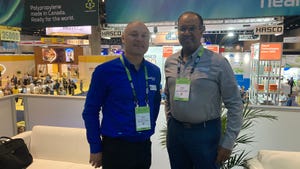Mature Industry Still Has Room For Growth
January 31, 2003
Suppliers of PVC resins appear to be on solid ground. They have managed to stave off attacks from various interest groups and been able to push through price increases in the last six months by some 30 to 40%. PVC still is the second-most popular plastic (after polypropylene), accounting for 20% of all polymers used, with most of the usage in the construction/building industry.
PVC remains popular for a number of reasons, including its durability, but low price has always been its trump card. But as PVC suppliers try to rebound from a year of poor earnings, any further price increase they attempt could cause other materials to become even more competitive. In some end-uses, such as rigid packaging, a transition from vinyl to PET or polypropylene in low-value applications, like dishwashing detergent bottles, is already occurring, regardless of pricing. In construction, polyethylene and PP continue to erode PVC’s majority share of the plastics pipe market, due to changes in pipe formulations. Still, PVC prices, after the recent dramatic rise, now only approach levels last reached in mid-1997.
At the second World Vinyl Forum late last year in Chantilly, VA, economist Irving Leveson projected global PVC demand will grow at an average annual rate of 4.3% through 2020, to a value of at least $59.2 billion, compared to $27.7 billion last year.
From 2003 to 2020, PVC consumption in China is predicted to rise by 9.1% per annum, while annual growth in India will average 5.8%, according to Leveson. For all of Asia except Japan, demand will rise 7.6%/yr over that period. For developing regions, which include Eastern Europe, Russia, and parts of the Middle East and Africa, growth will be 6.6%/yr.
Growth in developed regions will be noticeably slower, says Leveson. It will be at 4.1%/yr in the U.S., 3.5%/yr in Canada, 2.1%/yr in Western Europe, and 1.8%/yr in Japan. Meanwhile, Kerry Satterthwaite, senior research editor at Applied Market Information Ltd., Bristol, England, says PVC demand, even if economic growth reaches forecasted targets and energy prices do not increase, will not grow by more than 2% in 2003 in either Europe or North America. Moreover, much of the light expansion will be restricted to the first six months of the year, due to seasonal demand in construction.
In both Japan and Western Europe, the combination of a mature market, materials competition, cutbacks in building and infrastructure investment, and environmental pressures is hampering growth. Slow growth in Japan has led many domestic suppliers to shutter plants or shift production to other countries. In December, Mitsubishi Chemical, the owner of V-Tech, with 390,000 tonnes/yr of capacity — and one of the four largest Japanese PVC suppliers — announced it would reduce output at two plants. Others have shuttered or plan to shut down plants next month, including Kureha, Chisso, and Kaneka. Asahi Glass Co. has halted domestic resin supply, though it continues to run plants in three countries with growing demand: Indonesia, Thailand, and Pakistan.
Plant closures in regions where many small plants exist, most notably southern Europe and the Far East, are expected in favor of larger plants and resin imports. Satterthwaite predicts that Asian PVC demand in construction will be above 5% in 2003. This will lead to higher resin prices and improved margins for producers.
Supplier mergers are especially expected in Western Europe, as many North American suppliers already have completed mergers or acquisitions.
Last November, French holding company EMC announced that it wants to sell its 40% stake in Belgium’s Tessenderlo. Norsk Hydro has had its PVC operations up for sale for four years without landing a buyer. modern plastics sister publication Chemical Week last August reported on a potential merger between German suppliers Vinnolit and Vestolit that was to be completed last October, but negotiations are ongoing. Norsk Hydro’s business could be included in the deal, which would make the merged firm the largest European supplier, ahead of EVC and Solvay. Atofina, currently the third-largest producer, also would be passed by a merged Vinnolit and Vestolit.
You May Also Like


